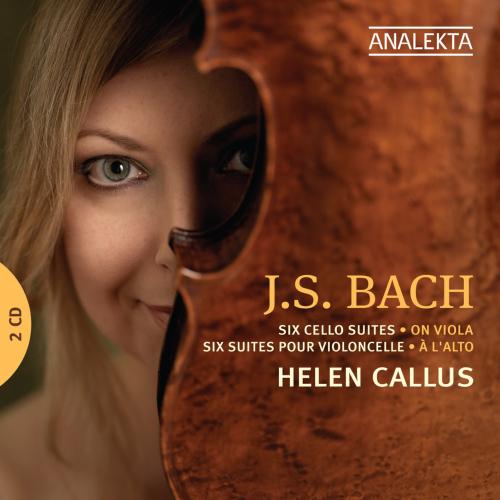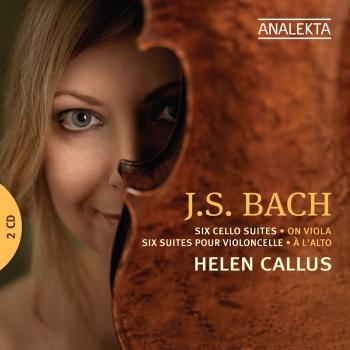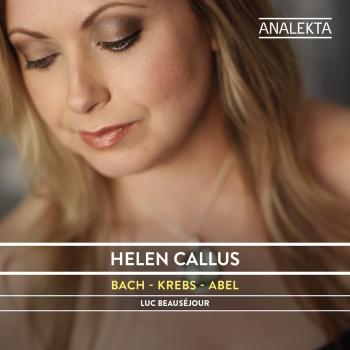
J.S. Bach: Six Cello Suites on Viola Helen Callus
Album info
Album-Release:
2011
HRA-Release:
28.11.2019
Label: Analekta
Genre: Classical
Subgenre: Chamber Music
Artist: Helen Callus
Composer: Johann Sebastian Bach (1685-1750)
Album including Album cover
- Johann Sebastian Bach (1685 - 1750): Suite No.1 in G major, BWV 1007:
- 1 Suite No.1 in G major, BWV 1007 / I. Prélude 02:08
- 2 Suite No.1 in G major, BWV 1007 / II. Allemande 03:40
- 3 Suite No.1 in G major, BWV 1007 / III. Courante 02:21
- 4 Suite No.1 in G major, BWV 1007 / IV. Sarabande 03:07
- 5 Suite No.1 in G major, BWV 1007 / V. Menuet I & II 02:50
- 6 Suite No.1 in G major, BWV 1007 / VI. Gigue 01:32
- Suite No.2 in D minor, BWV 1008:
- 7 Suite No.2 in D minor, BWV 1008 / I. Prélude 03:34
- 8 Suite No.2 in D minor, BWV 1008 / II. Allemande 03:10
- 9 Suite No.2 in D minor, BWV 1008 / III. Courante 02:16
- 10 Suite No.2 in D minor, BWV 1008 / IV. Sarabande 04:55
- 11 Suite No.2 in D minor, BWV 1008 / V. Menuet I & II 02:59
- 12 Suite No.2 in D minor, BWV 1008 / VI. Gigue 02:45
- Suite No.3 in C major, BWV 1009:
- 13 Suite No.3 in C major, BWV 1009 / I. Prélude 03:30
- 14 Suite No.3 in C major, BWV 1009 / II. Allemande 03:38
- 15 Suite No.3 in C major, BWV 1009 / III. Courante 03:17
- 16 Suite No.3 in C major, BWV 1009 / IV. Sarabande 04:51
- 17 Suite No.3 in C major, BWV 1009 / V. Bourée I & II 03:57
- 18 Suite No.3 in C major, BWV 1009 / VI. Gigue 03:13
- Suite No.4 in E flat major, BWV 1010:
- 19 Suite No.4 in E flat major, BWV 1010 / I. Prélude 03:35
- 20 Suite No.4 in E flat major, BWV 1010 / II. Allemande 04:13
- 21 Suite No.4 in E flat major, BWV 1010 / III. Courante 03:11
- 22 Suite No.4 in E flat major, BWV 1010 / IV. Sarabande 04:30
- 23 Suite No.4 in E flat major, BWV 1010 / V. Bourée I & II 05:04
- 24 Suite No.4 in E flat major, BWV 1010 / VI. Gigue 02:44
- Suite No.5 in C minor, BWV 1011:
- 25 Suite No.5 in C minor, BWV 1011 / I. Prélude 06:21
- 26 Suite No.5 in C minor, BWV 1011 / II. Allemande 05:06
- 27 Suite No.5 in C minor, BWV 1011 / III. Courante 02:17
- 28 Suite No.5 in C minor, BWV 1011 / IV. Sarabande 03:46
- 29 Suite No.5 in C minor, BWV 1011 / V. Gavotte I & II 04:50
- 30 Suite No.5 in C minor, BWV 1011 / VI. Gigue 02:19
- Suite No.6 in D major, BWV 1012:
- 31 Suite No.6 in D major, BWV 1012 / I. Prélude 04:46
- 32 Suite No.6 in D major, BWV 1012 / II. Allemande 07:19
- 33 Suite No.6 in D major, BWV 1012 / III. Courante 03:23
- 34 Suite No.6 in D major, BWV 1012 / IV. Sarabande 04:59
- 35 Suite No.6 in D major, BWV 1012 / V. Gavotte I & II 04:05
- 36 Suite No.6 in D major, BWV 1012 / VI. Gigue 03:57
Info for J.S. Bach: Six Cello Suites on Viola
Hailed by American Record Guide as "one of the world's greatest violists", British violist Helen Callus performs as a recitalist, chamber musician and concerto soloist. The six suites by Johann Sebastian Helen Callus performs here the well-known and beloved Bach's Suites for solo cello.
Johann Sebastian Bach’s six suites for solo cello are well-known and beloved works that are central to the repertoire of any cellist or violist. However, they are also works fraught with uncertainties, ranging from the circumstances of their composition to performance practices. It is not known when, why or for whom the suites were composed, or even for exactly which instrument they were intended. Further questions bedevil performance choices. What did Bach intend in the way of bowings and articulation? Did he have French or Italian bowing practices in mind?
The first surviving copy of the suites, by Johann Peter Kellner, was made in 1726, so the suites must have been composed before then. It seems reasonable to assume that Bach wrote them around 1720 in Cöthen, at about the same time as the six sonatas and partitas for solo violin, but there is no hard evidence to support this. Anner Byslma speculates that the suites might have been composed earlier, and there is no compelling reason to assume that all of the suites were composed at the same time.
Even the seemingly straightforward designation of suites as being for “violoncello” is problematic. The word “violoncello” could refer to instruments of different sizes and playing techniques in the early 18th century. The cello as we now know it emerged in Italy around the 1660s, with its size standardized by Stradivarius at the beginning of the 18th century. In Bach’s day, “violoncello” could refer to the older, larger instruments or to the smaller instruments on the Stradivarius model, as well as to the so-called violoncello da spalla (or viola da spalla), an instrument slung over the shoulder and played with something closer to violin technique than to cello technique. Furthermore, not all of the suites are intended for the same instrument. The Sixth Suite requires a five string instrument, which could either be a five-string cello held between the legs (perhaps a violoncello piccolo), or a five-string violoncello da spalla. Bach included prominent parts for a “violoncello piccolo” in a number of his cantatas written in Leipzig between 1724 and 1725. For some of these cantatas, the violoncello piccolo lines are either written in treble clef, or contained in the first violin part, suggesting that they were played by a violinist, on a cello slung from the shoulder. As Mark M. Smith argues, it seems quite possible that the Sixth Suite was written at the same time (possibly for the same player and instrument), and also intended be played on a shoulder-slung instrument.
Any attempt to guess the circumstances under which the suites were composed is contingent upon the above uncertainties. If Bach did compose the suites around 1720, and if he did intended them (or at least the first five of them) for a cello held between the legs, then, as David Ledbetter suggests, he might very well have composed them for Christian Bernhard Linike, an excellent cellist who arrived in Cöthen shortly before Bach did. If they were intended for a shoulder cello, then perhaps Bach, who played violin and viola, played them himself.
In addition to these problems, no doubt the most troubling circumstance for the performer is that we have no manuscript for the suites in Bach’s own hand. All published editions are based on some combination of 18th century copies. The sources differ significantly in terms of bowings and articulations, and occasionally even disagree about pitches. The copy with the most biographical authority is that made by Anna Magdalena Bach, sometime between 1727 and 1731, but she was not a string player, and a comparison between her copy of the solo violin sonatas and partitas and Bach’s own manuscript shows her to have been neither precise nor unambiguous in her labors.
These are suites for some sort of cello, but, as Bylsma points out, it is entirely possible that Bach played them for himself on the viola. Bylsma even finds some chords and string-crossings that fit the hand of a violist better than that of a cellist. The cello suites have been part of the viola repertoire since the beginning of the 20th century. In 1916 G. Schirmer published a viola transcription edited by Louis Svecenski (principal violist of the Boston Symphony Orchestra, and violist of the Kneisel Quartet), following it with another edition by Samuel Lifschey (principal violist of the Philadelphia Orchestra for thirty years) in 1936. Although she did not publish an edition of the Bach Suites, Lillian Fuchs was instrumental in making the suites part of the standard concert and pedagogical repertoire for violists through her advocacy as a performer and as a teacher, much as Pablo Casals had done for cellists. A number of other transcriptions followed after the Second World War, including one by Milton Katims who had worked with Casals at the Prades Festival. Until fairly recently, viola editions were heavily edited, with bowings and dynamics added liberally to facilitate expressive performances in the Casals and Fuchs manner.
Helen Callus plays from the critical edition prepared for Peters by Simon Rowland-Jones, but has made her own decisions about articulations, dynamics and ornamentation based on the original sources. She plays the Fifth Suite with the scordatura tuning requested by Bach, tuning her top string down from A to G (this suite can be played with a normally-tuned instrument, but at the expense of leaving some notes out of Bach’s chords and of different timbres for some notes). Callus plays the Sixth Suite in G major, rather than Bach’s D major. Although this involves changing Bach’s key, it also means that the viola version is closer in tessitura to Bach’s original than it would be in D major (a fourth higher rather than an octave), and it allows for more of Bach’s effects with open strings to be preserved.
Helen Callus, viola
Recorded on September 19, 21 and 23, 2010 at: Salle Francoys-Bernier, Domaine Forget
Helen Callus
Hailed as “one of the world’s greatest violists” (American Record Guide), and “one of the foremost violists of her generation” (Fanfare magazine), Helen Callus continues to captivate audiences with her lyrical tone, technical command, and profound artistry.
Sought after as a recitalist, chamber musician, and concerto soloist, Ms. Callus has performed with such world-class ensembles as the Tokyo and Juilliard String Quartets and the BBC Concert Orchestra, and delighted audiences around the world, in Russia, Europe, New Zealand, Australia, Canada, and throughout the US.
Ms. Callus’s career includes distinguished work as an award-winning recording artist. Her seven releases include the works of Walton, Prokofiev, Vaughn Williams, J.S. Bach, Gordon Jacob and more, and have been met with high critical acclaim. The American Record Guide observed, “Only really great artistry can hold a listener in thrall like that, and that is the artistry of Helen Callus”.
Ms. Callus currently holds the appointment of Professor of viola at the University of California, Santa Barbara, and has recently accepted an invitation to join the faculty of the prestigious Colburn Young Artists Academy in Los Angeles. Sought after as a visiting professor, she has given over 80 master classes at many of the world’s leading schools of music. She also served as the first female President of the American Viola Society.
Born in England, Ms. Callus graduated from London’s Royal Academy of Music, and was bestowed an Honorary ARAM and FRAM for her achievements in the field. She continued her graduate studies at the Peabody Conservatory.
Ms. Callus plays on a viola made for her by Gabrielle Kundert which is a copy of the ex-Primrose Amati.
This album contains no booklet.












